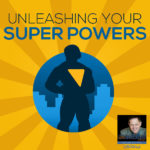
Tracy Hazzard is the cofounder of Hazz Design and cohost of the WTFFF?! podcast. She talks about 3D thinking in how she and her husband, Tom Hazzard, started out their entrepreneurial journey, how they floundered for a few years, and how they have put systems in place to get them where they are today. She also discusses how those years of floundering has taught her so much of what she needed to know to be successful today and in the future.
 Tracy Hazzard, Inc. Columnist and Product Strategist for Hazz Design has co-designed and developed 250+ consumer products generating more than $1 Billion for her clients. She works with design-leading brands like Martha Stewart Living and Herman Miller and retailers like Costco and Target. She holds over 37 utility and design patents with an unprecedented 86% commercialization rate. For 25 years, Tracy has been pushing businesses to rethink their product lines as a strategy to design in success and increase revenues. A proponent of intentional innovation as a competitive advantage and asset-builder, Tracy is the co-inventor of 37 patents with her husband and partner Tom. Besides being featured in Harvard Business Review, Forbes, Wired, and CNN Money, Tracy is also co-host of the top-ranked podcast, WTFFF?! – the starting point for all things 3d printing.
Tracy Hazzard, Inc. Columnist and Product Strategist for Hazz Design has co-designed and developed 250+ consumer products generating more than $1 Billion for her clients. She works with design-leading brands like Martha Stewart Living and Herman Miller and retailers like Costco and Target. She holds over 37 utility and design patents with an unprecedented 86% commercialization rate. For 25 years, Tracy has been pushing businesses to rethink their product lines as a strategy to design in success and increase revenues. A proponent of intentional innovation as a competitive advantage and asset-builder, Tracy is the co-inventor of 37 patents with her husband and partner Tom. Besides being featured in Harvard Business Review, Forbes, Wired, and CNN Money, Tracy is also co-host of the top-ranked podcast, WTFFF?! – the starting point for all things 3d printing.
Listen To The Episode Here
3D Thinking – Interview With Tracy Hazzard
Hey, everybody. Welcome to The Unshackled Owner podcast. I’m Aaron Young, I’m your host. I’m delighted to be with you again today. Thanks so much for being here. It means a lot to me. We’ve been getting some good mail and getting some good outreach through the social media world from people that are listening to the podcast. Thank you, thank you so much for embracing this. I’ll just ask you, if you like the content that you’re hearing here, if you like what we’re talking about, if you find value in it, please share it with your friends. If you’re coming to my website or if you’re finding it on iTunes or Stitcher or some other place, if you’re out there, please write in a review or give a thumbs up, if you’re on Stitcher, give it a positive endorsement. It will really help us grow and get this information out to more and more business owners. I’ll you what, this is stuff that business owners who are growing a business, they need, need, need to learn about. Because we don’t want to just to have a bunch of people run around, wasting time, spinning that hamster wheel. We want to get people moving from where they are to their desired outcome. If you have the right training, the right mentorship, the right ideas, you’re going to get there a lot faster.
Anyway, that brings me to today. I’m really excited for my guest today. Her name is Tracy Leigh Hazzard. She’s one of the founders of Hazz Design. I’m going to have her tell you more about what that means in a minute. I’ll just tell you this, Tracy and her husband Tom and their team have successfully taken over $2 billion worth of products to market. These folks specialize in identifying good opportunities, putting together the prototypes, finding homes out there in major stores and really taking a great idea and taking it all the way to the finish line. It’s really cool what they do, that is what they’re famous for. We’re going to have a lot of fun stuff. Tracy, are you there with me? Are you on?
I am. So excited to be here, Aaron. Thanks for inviting me.
Tracy, I always love getting to visit with you. Full disclosure again everybody, Tracy is another one of my friends. You guys are going to hear from a lot of people that I know and admire and respect. Tracy, it doesn’t matter what she’s talking about, whenever she’s in an event, if she’s giving a talk, the room is full. She’s awesome. Tracy, let’s just go and fill in the bio just a little bit. What do you want the people to know about where you came from and maybe not even all the way how you started in business, but what brought you to the place of becoming entrepreneurial? When did you make the decision? How did you start out your entrepreneurial journey?

3D Thinking; That’s what I thought wanted to be, a corporate designer, the whole thing was my goal.
Wow. I met Tom, my husband and partner, at Rhode Island School of Design. We met I think the first day of school, he insulted me. He called me a Valley girl because I was from California. From there on, we became really good friends and eventually got married before we graduated. I was all ready to go into the corporate world, super excited. I was one of the first graduates to get a job. I missed my graduation ceremony rehearsal to go and do an onsite interview for a company in South Carolina called Milliken, one of the top textile companies in the world. I was excited. That’s what I wanted to be, a corporate designer, the whole thing was my goal. I went down there, had a great time, Tom hated it. He couldn’t find a job. He was always an entrepreneur at heart and I was not, at least I thought. We did a couple of moves after that and I worked for another great company, Herman Miller. I helped design the Aeron Chair, which is a famous icon. I got to help with that.
I saw a whole different world there because a lot of their designers were independent. They were kicked out of the house. There was this great blend at Herman Miller of in house engineers and designers and project managers and out of house designers and boundary pushers, for a lack of a better way to describe it. That’s what they were, they were these thought provoking boundary pushers, like Bill Stumpf, who designed the chair. That inspired me, I wanted to be that. That was what I wanted to grow into. At some point, there was a lot of changes and things happened. Tom invented something based on my complaint about product. He wanted to start this business. I looked at him and I said, “You’re not starting this business unless I’m running it with you because you’re a terrible business manager.”
Great creative mind but he’s not a systems person so much as an inventor?
Exactly. Love him, he is the best innovative mind. I love working with him, but I was like, “Oh no, this is going to be bad for our family.” We had a baby and all of that at that time. We started this business together called ttools. It was surrounding the PalmPilot economy. We had an eCommerce site, we had all these inventions that went with it. It was a stylus pen for handheld computers, a screen and a keyboard and a whole bunch of other things. They were all these patented inventions and they were great. People loved them.
They were great for the Palm Pilot?
Yeah. We had this growing family. I was in this crazy entrepreneurial world of running a company. Gosh, what was I? Probably 27 years old, running this company. It was just, every day felt like a fire fight. I was overwhelmed and scared. I had all these employees. I didn’t know what to do. I felt like I had no one to talk to. That was so scary for me. I kept coming home in tears and going, “I just want to go back to the corporate world. I don’t want to be an entrepreneur, it’s too hard.” One day, IDEO, which was the largest industrial design firm in the world, and Palm Computing, who invented the PalmPilot, infringed on our patent. I thought life was over. Talk about just killing your company. Just, instantly, how are we going to fight Goliath and the whole thing? I went to bed in tears and woke up the next morning and said, “This is not the person that you are. You’re going to go out there, you’re going to look at your team and you’re going to brainstorm and figure out and innovative way out of this.” Sure enough, that’s what we did. That’s when I found my stride as an entrepreneur. It made me want to keep doing it. Tom and I found that I loved working together and we loved the mind share and the innovation process and the visionary side of things together.
You started out together and you came up with all these patented products for the PalmPilot, which the PalmPilot had its little lifespan.
We were out of it way before that.
Even if they hadn’t infringed, it had a limited lifespan anyway. You did that and you’re running the business and then this big wall happened where they got in your way and you had to start innovating out of it. What did you do to go from being focused on a specific channel, PalmPilot accessories, to expanding out and being involved with looking at lots of things? How did you morph from being very, very specifically focused on selling things you’d invented to becoming a resource for other investors?
I wish it was a much more direct path, but I think we floundered for about, I don’t know, seven years in the middle there and trying to figure that out. The company had like a $5 million valuation at the end of it. We sold off the patents in pieces and that’s how we got out of it. We looked back and we were like, we don’t know how to expand this business into what we wanted it be, which is what we have today as Hazz Design. We didn’t know how to do that from the existing place we were in. We had thirteen LLC members and they were all demanding. It was really difficult.
They were investors?
They were Angel investors, friends and family mostly. They were all really demanding and I had to produce financials. It was good, it was so disciplined for me and taught me so much about how I needed to run my business differently the next time. We realized that what we needed to do was just to scrap ttools and start again. That starting again was not an easy road, because in the scrapping pro

3D Thinking: I wish it was a much more direct path, but we floundered for about 7 years in the middle there and trying to figure that out.
cess we gave investors back, they got a return on their money and we sold off the patents and then got long term royalty on it, which was always really good for us. That’s one of the models we keep using as our way of keeping income going even when times are slow.
I want to go back. You said you floundered around for seven years. I want to ask two questions about what you just said and just unpack this a little bit more. A few episodes ago, we talked about bootstrapping versus bringing an outside equity capital. What’s your short answer to, going forward, would you rather bootstrap or would you rather bring an equity capital based on your experience?
You’re hitting on the point that I’m at right not where I’m like, “Do we bootstrap it or do we do this right now?” I’ve done both. I prefer the bootstrap method because I like a lot of control. In our industry, when you’re required to be a visionary and designer, having more control can be extremely helpful. That’s my first preference. However, there’s a speed issue sometimes. We are personally hitting on a speed to market in a particular technology category. I’m at that point where I’m like, “I don’t know if I can do this in a bootstrap method as much as I prefer.” I’m looking at my options right now.
The upside is, when you raise money, and this is what our guest said the other day, when you’re raising money, the idea is that you want to do something big and you want to do it fast. That’s what you’re saying. For us to get to market with emerging technology as rapidly as we want, we may need some extra capital. Which the only way for us to find that is to bring in outside investment money. You’re not independently wealthy, you’re not a Rockefeller where you can just tap into the family foundation.
No, I come from a long line of immigrants who worked really hard to make ends meet. My grandfather was a brick mason and used to build chimneys and fireplaces and all sorts of things. Big hardworking, blue collar families.
We’re going to go way off the track here for a second. One of the things that I’ve learned is that we are the product of our ancestry, especially people like your parents and grandparents that you would’ve known or would’ve had influence on your folks or directly on you. It’s interesting that you said that you’re much more of a procedural person and Tom is more of this creative energy. It’s really interesting, you talked about your grandpa being a brick mason and you think about not only the very specific way and the variety of ways that brick masons can build a wall, build a chimney, put up a building. Not only are they very specific but they have a huge responsibility. People could be hurt by them failing in doing a good job. There’s a responsibility and there’s a practicality and there’s a system. That’s the first person you thought of when you’ve made a comparison, was your grandfather,the brick layer.
There’s also an art to it though. That’s what I found over the years when I used to watch him and my dad of course, because my dad worked for him for a while when I was very young. My dad, whenever we needed something built, he built it. I found that there’s an art to it as well. The bricks that you choose and how you do that, it’s intuition and it’s creative statement as well. Because sometimes bricks are darker or lighter. I always found I was fascinated by the fact that it was a great meld of both things, of this science, technology in a way. The mix of science of cement, it has to be perfect or you do have flaws. All of that just always fascinated me. Actually you’re right that that’s exactly who I identify myself, as that mix of that.
Isn’t it interesting also, just to go another step down the rabbit hole, that a brick mason is thinking, especially unless you’re just building a wall, but almost anything they’re going to build, they’re having to think about not just up and down and side to side but depth. They’re thinking three dimensionally. They’re building something that’s a three dimensional thing. They’re putting together blocks with mortar and they’re building something. If they’re going to create art out of it, they’re having to think about, how is this going to work in all directions? It’s interesting to me that now, one of the big things that you guys are doing, where you’re making a giant splash, you and Tom, is with everything to do with 3D printing. I can’t help but connect these points, Tracy. I didn’t mean to go this way, but I’m thinking, isn’t it interesting that you went immediately to your grandpa, also your dad. I’m looking at going, I know you guys are leaders, thought leaders in 3D printing and bringing that into small manufacturing, bringing it into homes. Tell me how you got there and tell me what you think. Do you see a linkage? Have you always seen a linkage or you’re just seeing it right now in this interview?

3D Thinking: That mess in the middle, it was a chance for us to grow.
No. Actually, it’s really been in the last few weeks that it has come to me as that. We had to go down when I said we had this floundering for seven years, it wasn’t that. I didn’t want to bootstrap it as much as we had done it the first time. What happened for me was that we were holding back from restarting the business the way that we wanted to, but it was really good because it gave Tom a chance to take some jobs. He was a VP of design and did some other things like that. It helped him manage people and learn some of the business things that I felt like he didn’t have when we started the business the first time, when we started ttools. He got that in that timeframe. It was a chance for him to grow and do that and it was the chance for me to do some other things that I wanted to do. I did a lot of writing and that’s where I expanded into the place that I am from that standpoint. Those things, I looked back at that and go, “Wow, we really needed all that.” I just look backed at it this past year as we were reflecting on our financials from the past year and what worked and what didn’t. I started to really put the pieces together and it seemed like, wow, doing this Inc column that I’ve been doing for the last year, I interviewed all these very different people.
Hold on. Folks, she just said that she writes for Inc.com, she does a regular column for Inc. I didn’t want that just to fly by. People may be thinking your talking about some black smudges on your P&L. You’re saying that by adding the Inc column and meeting the people there, keep going with your story.
By adding that, I actually was able to fill in a bunch of pieces to this vision plan that I have going forward for where we’re going to take our 3D print business that I couldn’t have done. I would have never had those people in my circle. I would have never stepped out to meet them. I don’t think I would’ve even met them through our networking and our entrepreneurial circles. Because I write an innovation column, so they have a little bit of an innovation and tech edge that I needed to be exposed to and access to perhaps in the future, to be able to help me understand how to get the capital that I want because it’s not an Angel investor round that I’m going to need eventually. Getting that exposure all of a sudden I went, “That’s why that happened to me this past year.”
The two big takeaways that I just got from what you said, one is that there isn’t always this immediate direct path from where you are to where you have imagined that you want to be. You know where you are and you have a sense of, “This is what I think success would look like exactly.”I’m exacting on precisely where’s the destination you want to reach. You’re here and you want to get there. A lot of times we try to draw this beautiful, clear, unobstructed, we understand every step along the way path. The fact is, it almost never goes that way. They’re all these things that you have to make choices about like, “Should I start writing for Inc? Should I do this column or is that taking away from other things that I’m doing?” What you’re saying is that by saying yes to that opportunity, making a calculated risk with your time, it actually opened up opportunities and relationships that, not only would you not have had, you would have no way to even explore them. You actually learned things that you didn’t know you needed to learn to accomplish the goal. Did I get that right?
Exactly. If you looked at it completely from hourly return on investment of time, it would’ve been a complete failure last year. But then you sit back and look at, “Wow, I’ve just added this person to my network and their network to my network. I’m going to need them next year. I can pull in a favor.” I was thinking the other day about actually your men’s group, Aaron. Greg and everyone there, Greg Reid. I was thinking about them and I was like, “If I’m going to go and pitch to a group of VCs, I’m going to pull a favor with Greg and Aaron and I’m going to go and pitch in front of you guys,” because that would be the most intimidating.
There’s an interesting group.
That would be extremely intimidating to me. That’s what I would want to do, to get over any fear that I might have about pitching to a VC. If I pitch to your group, and I know it’s friendly at the end of the day, but it still would be intimidating to me and that would help me overcome it. I have the ability to ask for that favor. That wouldn’t have happened if I hadn’t met you guys over the last couple of years and done all of that.
That’s really important. Here’s a couple more interesting takeaways, folks. One is Tracy’s saying, “I need to stretch myself so that I’m prepared to receive all that I want to receive. I have to go do something that I know will be challenging. But hey, isn’t it awesome that I know people who are in a different business, a different circumstance and I can go get access to the founder of UGG’s boots, to the founder of the Make-A-Wish Foundation, to the guy that invented Pictionary, to the guy that is one of the top sports agents in the country?” How interesting is that? Those people are all right there for you to have really pretty easy access to, Tracy. I think it’s partly who you know and partly the relationships that you’ve established. But it’s also the guts to ask, to step out in front of those people and to humble yourself enough to say, “How is this? Is this okay? What should I do?” Most people just stay in a small little world, a small little business, a small little group of friends. They’d stay hunkered down inside of a place where they have tremendous influence, where they can feel safe, important, maybe the smartest person in the room. Successful people surround themselves with those that make them stretch because if you’re always the smartest person in the room, you’re not growing.
I totally agree.
Good for you. By the way, we have a meeting in the next week. I’ll bring that up if you want me too.
This is really interesting what you just said there because this is the thing I think we get to too often. I don’t want to generalize women, men or anything like that, but I find that the women entrepreneurs I talk to are more this way than the men are.
Which way is that, which way? Bold or hunkered down?

3D Thinking: In trying to do something so hard and so new, I would have to step out of that perfectionist mode.
It’s a little too perfectionist about things. I realized that over the last year and a half that I’ve been formulating a plan and I haven’t jumped, we haven’t dove in, it’s never been the right time, we haven’t gone to do this yet. I had to sit back and reflect on that and say, “Why is it not the right time for me?” I realized that I was sitting up there saying, “I’m trying to hold myself as this great mentor and consultant and all this stuff.” In trying to do something so hard and so new, I would have to step out of that perfectionist mode and say, “Wow, I don’t know what I’m doing. I’m out of my element.” That’s hard.
When you finish something and you put it out in front of people, then you have now opened yourself up for judgment. Most people don’t want to be judged. If you’re working on a painting and people say, “Hey, how’s that painting going?” You go, “It’s almost done and I’m almost done. I’m really excited about it. It’s going to be exciting. It’ll be great. It’s going to be my best thing ever, but it’s not quite done. It’s not quite done. My digital program’s not quite done. My book’s not quite done.” Because as soon as it’s done then everybody can shine the light on you and all of your concerns about your failings, your warts, your blemishes. You’re afraid they’re going to be on display. In fact, most people have never done a lot of the things that we’re afraid that we’re going to be judged harshly on. They haven’t ever gone out and asked for money. They’ve never written a book. They’ve never made a painting. Some haters are going to hate, but for the most part, people are going to go, “That’s really cool. Good for you for doing that.” Then they’re going to forget all about what you did and go on to the things that they’re doing that they’re so worried about. This fear of judgment is so overblown and overvalued.
I don’t know that it was just completely a fear of judgment for me as much as it was a fear of, “I’m not qualified enough for this.”
According to who?
That’s ridiculous.
It is judgment.
It was sitting in your Unshackled Owner presentation in San Diego, gosh, what was that, I don’t know, four or five months ago. In November. I sat down. I don’t know if you used the word, but big hairy audacious goal.
Your BHAG.
Your BHAG. What’s your big hairy audacious goal? I sat down and I was doodling in my notebook, which is what I do when I’m at conferences because it’s a free flowing way of thinking for me. As I was doodling, I wrote, “I want to build a $1 billion company.” I went, “Oh my God, I’ve never said that out loud. I never wrote that down before. I may be thinking that, but I never wrote that down before.” Jason Sisneros. Awesome guy. I never heard him speak in person. I’ve seen him on Facebook and stuff before, but I’d never seen him. He was just in your face the whole time that he was giving that talk, and I needed that. He basically pushed back and says, “What are you afraid of losing if you don’t go after that big goal?” That’s basically was the message he was giving. I looked at him, I went, “Wow, what am I afraid of losing? I’m really proud of my relationship with my husband. We’ve been doing this for 25 years together on and off. I’m not afraid of losing that. I’m not afraid of losing my clients. What am I afraid of losing in this? Why am I not doing this?”
If you say a billion dollar business and all you ever do is get to $750 million in revenue …
That’s pretty darn good, huh?
It’s pretty darn good. Remember what Les Brown always says, “It isn’t that you aim too high and miss, it’s that you aim too low and hit.” That’s what most of us are doing. We’re saying, “I’m willing to play small because nobody’s going to tell me I was a fool or silly or it was folly for me to go after my billion dollar goal.”

3D Thinking: What’s your big hairy audacious goal?
For me, that side part of it though was the fear that I wasn’t qualified to run a billion dollar company. First off I said, “I don’t end up having to run it when it hits a billion dollars.” That’s your message. I got that loud and clear. I sat back and I said, “No.” My big a-ha of that moment was over the last eight years, Tom and I have built 250 $4 million product lines.” Wow.
That’s wholesale?
That’s wholesale cost. Double that for retail, that’s how you get to $2 billion of business. I’ve built that. I didn’t just do it once, I did it again and again and again. I built a $4 million product line. It’s a business for the people that I build it for. It’s a significant part of their businesses. Out of that 250 products, many of them went to a couple of the same companies. Two of those companies went from $100 million to $300 million in the time that we worked with them. I helped their companies grow and I helped them get bought out at the end of the day because we added so much value to their bottom line. They got bought and sold in that time period and then we were out of a job, which how we came back to like, “Wow, this model is not working for us as well as it’s working for everybody else. We better fix that.”
The point is, when we add up our life’s experience, when we think about what have we actually done in our life, you’ll be surprised. If you start to really boil it down to how many face to face sales presentations have you done? How many people have you closed to? How many dollars does that add up to? How many people does that affect? When you start to really boil down the impact of what you’ve done out there in your business, wherever you are right now, you’ll be surprised at the impact that you’ve already made. Tracy, I need to ask you a question as it relates to this whole idea of the unshackled owner. You started out, you had Goliath that battled with you, you guys went on, you’ve designed a new system where you’re able to take lots of products to market, do multiple millions of dollars. I know you and Tom work together. Do you work mostly with employees, with contractors, with vendors? Because you can’t do it all by yourself. How is your team designed?
That’s really interesting. I think that was the biggest takeaway for me from the first business, from ttools, when we had all these employees. Because we were doing light manufacturing on assembly of the products. I had a lot of employees, I had a big team. I felt very burdened. You and I have talked about this when you first started because unshackled meant something to me. It resonates when someone’s had that experience. It kept me up at night worrying, “Did I get enough orders this month?” All of those things stressed me out. When we built the business the second time around and we built it to be able to do very diverse product lines, we built it with a virtual team. I don’t mean like a VA like people do it here. I have an entire team that’s in Asia that works exclusively with me, but we don’t support them directly as employees. They are autonomous, they can take other projects, we just take up a lot of their time. We’ve been working with them for a very long time, for almost eight years now. We’re all very comfortable with how we work. We have systems in place to communicate. Everything flows and works and is as efficient as possible. That’s what we built to be able to handle that.
In addition to that, we have designers we bring in to expand our products. Tom and I, we basically design products for mass market retail. Consumer products you buy every day, things at Costco and Walmart and Target and a lot of the products lately are in Amazon. We get a lot of smaller companies coming to us that are startups and entrepreneurs doing what they call private label selling on Amazon. We can handle their business too, but sometimes you fall into a realm of, “I’m not totally the expert in beauty tools. I might bring in somebody who’s had a little more experience in that as a designer to work with us on a project.” I can flex and do that based on products that I don’t know enough about.
Folks, I’m getting so much gold here. I hope the listeners are hearing the same thing I’m hearing. You guys see an idea, somebody comes in and says, “We have this concept, we have this drawing,” or maybe they’ve got a napkin idea, you’re able to build out prototypes, you’re able to organize. These are physical products. You’re able to put together prototypes. Folks, listen to this. Remember the brick layer, remember this three dimensional thinking. These guys, Tracy and Tom do a great podcast and have a whole business on 3D printing that’s significant. It’s not exactly the same as everything that we’ve been talking about until now. Here’s the deal, think about this 3D idea. Tracy’s taking ideas, they’re taking concepts, they’re building them into prototypes, they’re finding manufacturing, they’re selling it in office depot, but they’re also selling on Amazon. Business is business is business. You can deliver products through a variety of channels. Depending on certain elements, you’re not going to sell tremendously heavy things necessarily.
We do. We sell furniture. They are heavy.
Let me go back. My point is, certain things may be better, more useful coming from online versus a store. You could buy like a piece of heavy equipment, you could a buy a big back loader, a backhoe, you could buy that online, but odds are you’re going to go to a place, a physical facility, look at it, learn how to drive it, get some instructions, have a place to get it serviced. That’s not an ideal Amazon product. There are other things that why wouldn’t you be buying online versus in a physical location. My point is, Tracy and her company have figured out how to take your concept and using all the different channels, not being limited to one way that they’re familiar with, they’re able to go to lots of channels to get people to this multi million dollar result over and over and over again. It takes looking at all of your options. There is not one path to the top of the mountain, there’s a thousand paths. Just because you’re familiar with one doesn’t mean it’s the only one or even the right one.

3D Thinking: For us, it’s not a direct route, but it has an order to things.
You’ve hit on it, Aaron. That is what we do and that’s really our secret sauce here. I share it because it’s come from having done it 250 times and made a whole lot of mistakes along the way to understand what that path is. For us, it’s not a direct route, but it has an order to things. This is what we tell people that is the unusual part. It’s not like we do anything different than another industrial design firm might, which is technically what we are, or another sourcing agent who finds manufacturers for you. The part that we do there is the same because there’s lot of great practices to model after. It’s the order we do it is what increases our success rate. Seven out of ten consumer retail products fail in the market. Tom and I have an 86% success rate from our products that we’ve done with our clients. When I say we have 250, those are just the 86% successful ones. They were a couple of duds in there. It happens.
We flipped that around because what happens is, we have an order we do things in. We essentially kill off ideas really quickly that won’t work, that are unlikely to be successful either in the sourcing process, the pricing process, the manufacturing process, whatever it might be. We know that because we’ve done it with so many different products and we know what works and what doesn’t and we synthesize that down to a specific order. Our key really is, at that very, very beginning, not getting attached to these ideas. These ideas are not babies. We don’t work with inventors very often because inventors get too caught up into their idea. We want business builders.
They have to stand on their own. It can’t just be your baby, your dream, it’s got to stand on its own. Another topic we covered a few weeks ago. Folks, listen. There’s a consistency that we hear from every one of these interviews. That is, you have to have a team, you have to have communication, you have to have systems. Team, communication, systems. I will add, exacting ways of measuring. That’s what you just said, Tracy. You’ve organized yourself so you know when to kill an idea quickly so you don’t waste a lot of time on it. You’ve figured out how to make assessments and say, “This one we keep pursuing. This one is a dug, we’re done with it,” so that you can have 86% success rate and just outperform the market. Guys, these are the fundamentals of becoming an unshackled owner.
The last few episodes, I’ve been playing with this. I’ve been calling it bullet points. A few rapid fire questions that we get some quick answers. I’ve been thinking about it, I thought, “What does bullet points have to do with The Unshackled Owner? Let’s come up with a better name.” Today and for the foreseeable future, we’re going to call these, not our bullet points, we’re going to call these are our golden keys. These are the specific golden keys that we’re going to get from our guest, for today, it’s Tracy Hazzard today. What are the golden keys that she can share with us to help all of us become unshackled. With that, you’re ready to go, Tracy?
Absolutely.
What book inspires you? What’s the one book that you tell people, “Hey, this is the thing you need to read as it relates to your world that you live in.”?
I read a lot of books. Tom will tell you, I read 300 books a year sometimes. Not this last year though, I’ve been too busy. The best book that I read in the last year and the one that I’ve been carrying forward with me is about lateral thinking. It’s Shane Snow’s Smartcuts. I absolutely love this book. First off, he’s an incredibly good writer. He’s a tech writer, he’s written for Wired and other places like that. This is not a new book. I hear that he has a new one coming out and I’m looking forward to that. This one, the idea of lateral thinking is really what we operate on and what you need to do to be extremely efficient, to cut to the core and not follow the hard way.
I love it. Smartcuts, we’ll have a link for that in the show notes. If you could go back, you talked about this fortuitous route that you followed it, ups and downs, if you could go back and change something, what would you change?
That’s a really interesting question. I love that question. I don’t think I would change anything. We’ve had a few hard times in there. People would say, “Wouldn’t you want to erase that?” On a bad day, I might still want to erase that. But I think it’s those flaws, I think it’s those mistakes, I think it’s those things that we learn from that really make your future possible. Right now, I’m sitting on the cusp of going, “All of those things have made it possible for me to be on the verge of building a billion dollar company.”
It’s that old idea. Tracy, you know my wife Michelle, she’s a great life coach.
Awesome.
One of the things that she talks about is this is what it looks like on the way to this thing you want. A lot of times, we want to go back and change things. There are things that I look back and I think, “Maybe if I hadn’t done this or if I had done that better or if I’d taken that opportunity,” but then we wouldn’t be where we are now. If we’re happy where we are now, going back and changing it could mess up the time-space continuum or something. Say something nerdy and Star Trek-y.

3D Thinking: It’s messy in the middle, but it is in that messy middle that the foundation is built for really making it successful.
That’s right. That wouldn’t be out of the realm of possibility in our office here. The way that I always like, the simple way that Michelle words it is, messy in the middle. It’s messy in the middle. When you’re in that middle, you just want to cry and you want to get out of it and you want anything to be on that other side of it, but it is in that messy middle that all that hard work that’s done that is the foundation builder for really making it successful.
If anybody wants to learn about Michelle Young, you go to Michelle At Play on Facebook. You can learn about my fabulous wife.
Just on a side note about Michelle, this is the thing about it, I’ve never done something like that. I’ve never hired a life coach before. I met her and in five minutes, I knew that was going to be the first thing that I had ever done for myself. That was just something just for me in an incredibly long time. It was the best thing that I had done in the last three years.
She’s going to love hearing that when this plays. You and I have a funny way that we came together actually. You walked up to me at an event and said you thought you knew me but it was actually you’d been listening to my podcast.
I was listening to your podcast as I was flying to the event. I was flying to Vegas, but we didn’t have an extra car to drive so I flew in. I’m flying in and I was listening to it on the airplane. I don’t know how I stumbled across your podcast back then. That was The Look Out. I get to the event and I was like, “Wow, this guy’s voice is really familiar. I feel like I know him.” Then somebody said something about podcast, that you are a podcaster, so I went, “Ow, that’s where I know him.”
Now, you guys are my producers of my podcast. We’ve completely closed that loop. See guys, complete transparency. Tom and Tracy have a great podcasting service. If you’re interested in podcasting, we’ll also make sure we put that in the show notes so you can find out. Tracy, back to the golden keys, which is supposed to be fast but I’m enjoying this conversation. Tell me, what’s your favorite quote?
Our favorite quote in this office is, “Hope is not a plan.” We say that all the time because it’s partially because you get really caught up in these ideas and you hope everybody’s going to love it and you hope it’s going to be great. Hope is not a plan, what we found is that you still have to work the system, you still have to work the plan, you still have to go through it. That doesn’t mean you lose your optimism about it. We fight for it. That’s how we decided that we were going to do 3D printing. It’s not very logical. If I sat down and said, “Let’s 3D print prototypes.” Why do we need to be spending time 3D printing prototypes? Some technician should be doing that. I can build prototypes faster in China or in a local foundry here if that’s what I need. I can do those things. Why do I need it?
Tom looked at me and said, “We need to skill build. We need to understand the technology and we need to figure out if there’s something we can do with it.” I went, “You’re absolutely right. I can’t look that up. I can’t read about it. I’ve got to experience it firsthand.” Once we did, we realized, “Hmm, this is the plan.” But this would be one of those things where you would give up too easily if you kept too strictly to your measurements, your guidelines, your plan. You have to sometimes really look for those opportunities. That doesn’t mean along the way, you don’t keep your gates, your screeners.
That’s interesting. Hope is not a plan. I totally agree with that one, guys. As we wrap up here, I’d like to ask you a couple of things. Any parting counsel? You’ve given us so much good values today. Some parting counsel. How do people reach out to you? Because guys remember, Tracy and Tom, it’s not all in their Hazz Design, but just for purposes of this show, they have their product business, taking products to market, and they have this whole 3D printing business and a really, really successful very, very niche podcast that’s all about it, it’s WTFFF is the podcast. Really the whole the whole idea is if you’re into 3D printing, this is one of the must listened to programs. You’ve got bringin products to market, deciding, 86% success, getting them out there, $2 billion plus in retail sales. Then you have the 3D printing world and then they also have this business that works with podcasters, lots of them, to do all the production work for their thing. There’s a lot of reasons you’d want to reach out to Tracy Hazzard and there’s a lot of background that she has. As you go out Tracy, what are some parting words of counsel and how can people get in touch with you? Then we’ll wrap up.

3D Thinking: You have to give your ideas a chance, but you also have to have some measurement tool.
Parting words. It sounds like we’re doing too much, but Tom and I are big believers in market testing. Our 3D print podcast, it was a market test, it was a test to see if people wanted to hear what we have to sell. We aren’t selling them anything at this point, it was just to test to see if people would listen. That’s one of the gates that we go through and it’s the very first one we go through, is to make sure people want to buy what you have to sell. Just because it’s not in its final embodiment, remember that perfectionist things we talked about earlier? Just because it’s not the final version of it, it’s not the perfect invented version, maybe it’s just a test of the category or a test of the product type or a test of “Can I reach the audience I want to reach through my marketing method.” Any one of those things are critical factors to success at the end. Sometimes we do these things that are little market tests out of the way. Sometimes we find, like with the podcast production side, it becomes a life on its own. That, it’s a little past startup stage. It’s in the growth stage right now, but it’s going to run itself in about two more months. That’s how close it is to being an unshackled business. That’s awesome that we took that from a little seed concept last summer and now it’s almost an unshackled business.
What’s the takeaway?
The takeaway for me and to you guys is that, you really have to sometimes give your ideas a chance, but you also have to coach that with some advisor or some measurement tool or some plan that says, “If I reach this point and it’s still not doing it, I have to sit back and reflect about why.” Is it important? Is it meeting my big hairy goal? Is it any of those things and I still need to keep going? Or do I have to stop because just because I like it doesn’t mean I should keep doing it?
Give them room to breathe but have some sort of coach, counselor or some trusted voice that can tell you, “This is working or this is not working.” Another favorite quote, “You can’t read the label from inside the bottle.” You need somebody sometimes to look at you objectively. How do people reach you, Tracy?
You can reach me at HazzDesign.com. There’s a link to my Inc column there. I would love to have more readers. You can never have enough readers as a columnist. That’s always a good way to help me out. 3D Start Point is actually where the home of the podcast is, the podcast, What the FFF?! If you know what that means, then you know you’re in the right place.
Guys, it’s been so nice having you here today, Tracy. Thanks for taking so much time with us and just share your journey and your experience. Folks, as I said earlier, there isn’t one way, but it will always come back, it will always come back to a great idea, a great vision, a team, metrics to measure what’s going on and having the courage and the tenacity and the audacity to keep pursuing your dream. That’s what will make you an unshackled owner. Until next time, guys. You go out and make it a great day. I look forward to seeing you next time. Make sure you tell your friends, you share, you like and you write reviews and let’s spread this information all over the business world. Take care. See you soon. Bye.
Links Mentioned
- AaronScottYoung.com
- The Unshackled Owner Twitter
- The Unshackled Owner Facebook
- Aaron Scott Young LinkedIn



